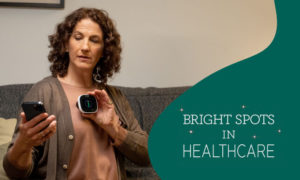Addressing your patient and clinician needs

Dr. Karen Rheuban, Co-Founder and Director of the UVA Center for Telehealth, and Dr. Nick Patel, Vice Chair of Primary Care at Prisma Health, recently joined TytoCare’s Director of Provider Solutions Nate Danner for a live webinar on telehealth’s role in improving access to healthcare while meeting clinician and patient demands. Click here to get the full webinar.
Alleviating today’s healthcare challenges
Staffing shortages are one of the primary challenges facing healthcare today. While outreach and recruitment efforts are underway, many health systems face widespread shortages, with primary care particularly impacted.
The US healthcare system, which is already overtaxed, is coping with rising rates of chronic illness, an aging population, and the long-term ramifications of the COVID pandemic. Staff burnout and the Great Resignation have further contributed to the palpable strain.
Dr. Patel described the challenges faced by healthcare organizations and how they impact patients, particularly those living in rural areas where access to healthcare providers is a challenge. Digital tools can be used to monitor patients, offering proactive, preventive solutions without the need for patients and clinicians to travel.
Healthcare automations can prevent care escalation, lower ED transfers, and eliminate manual and redundant tasks for providers so they can care for their patients more effectively. Automations can be used to determine when an in-person intervention or visit is warranted.
Telehealth is a natural extension of existing care delivery systems, expanding the health services available in the community to treat rural and underserved populations. Dr. Rheuban shared why satisfaction rates are high among patients and providers who utilize telehealth. Watch the full webinar to learn more.
Improving operational efficiency
Dr. Patel discussed telehealth’s acceleration during COVID. During the pandemic, asynchronous and automated services did much to keep patients safe and enable remote chronic care monitoring. People embraced telehealth for its ability to ensure care continuity, which arms patients and providers with life-saving data that, in turn, yields more accurate care and better chronic disease management.
Telehealth that integrates with EMRs certainly improves outcomes for patients, but it also improves quality of care by providers who glean insights that let them make better-informed decisions and maximize efficacy at in-person appointments.
Dr. Patel outlined his vision for hybrid multi-specialty care centers that facilitate patients’ health goals. TytoCare’s high-quality care and high-fidelity images have brought Prisma Health as close to patients’ bedsides as possible, helping Prisma meet performance goals.
Dr. Rheuban shared how virtual care has been embraced and supported by care teams at UVA. Telehealth has enabled seamless integration into EMRs and has filled care gaps in a broad range of use cases, such as caring for at-risk populations, patients with serious health disparities, post-discharge patients, rural monitoring, preventive screening, and more. Telehealth can address challenges such as health equity, diversity, and total determinants of health. Some challenges still lie ahead, such as the digital divide. Learn more in the full webinar.
Supporting remote delivery models
Dr. Patel explained that while you can get care from anywhere, it must be high-quality care that clinicians are comfortable providing. A hybrid model of care is needed, rather than an all-or-nothing approach. Telehealth completes the picture by providing vital patient information between visits.
There may never be enough primary care providers to cover the needs of a growing population, making telehealth and other automations increasingly important. As providers are expected to do more and more, flexible models can improve their work-life balance while ensuring excellent treatment and effective follow-up care.
Satisfaction with health plans is more important than ever before. As health systems move towards value-based care models, they require innovative approaches to remain competitive and differentiate their offerings. Digital solutions can offer efficient, high-quality care that is well-regarded by both patients and medical staff.
While telehealth can simplify care and minimize fragmentation, both doctors stressed the need for technology to simplify care, rather than overcomplicate it. Effective, intuitive solutions should provide maximum ROI and integrate well with workflows. Technology must be incorporated in a way that makes sense and doesn’t disturb trusted patient-provider relationships.
Dr. Rheuban discussed how public policy must change to encourage remote care models. While public policy supports investment in digital health, it is data that ultimately drives legislative decisions. Digital healthcare must address business goals to warrant funding and pave the way for additional policy changes.
Dr. Patel outlined the achievements he’s seen remote care accomplish in recent years, especially during the pandemic. As he stated, “We have to come together for the greater good. Supporting telehealth is supporting health.” Regardless of where patients are seen, the end goal is always keeping them healthy.
The discussion was an enlightening overview of where telehealth has been, where it’s going, and how it can be used to meet the needs of patients and clinicians. To access the full webinar, click here.

